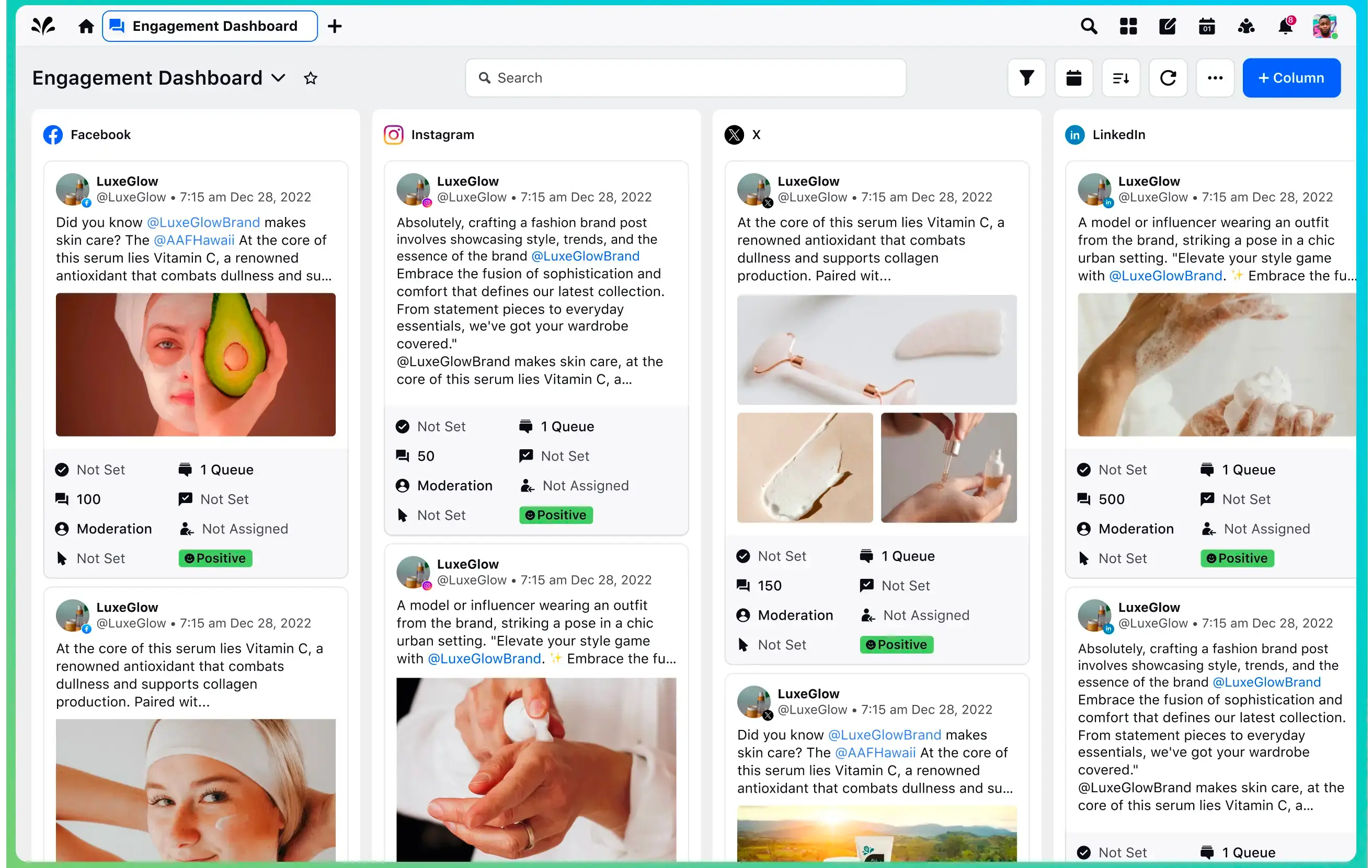The undisputed leader in social media management
For over a decade, the world’s largest enterprises have trusted Sprinklr Social for its in-depth listening, unmatched channel coverage, enterprise-grade configurability and industry-defining AI.

How to improve the Net Promoter Score of your brand
Customer feedback is the cornerstone of building a strong community of followers.
Quality feedback can help improve your customer experience and product/services if taken seriously and by acting on complaints or suggestions of your customers as soon as possible.
Deploying surveys is a great way to collect actionable feedback. Surveys take many shapes and forms, but there’s one survey that’s guaranteed to let you know if a customer will continue doing business with you or not.
The NPS (Net Promoter Score) is a one-question survey that helps determine customer loyalty — the likelihood your customers would recommend your products and services to their friends and family.
A low NPS indicates the brand has more detractors than promoters, which in turn means a higher number of unhappy customers and possibly dwindling sales.
Let’s look at some of the industry best practices that can help improve your NPS and boost customer satisfaction (CSAT), retention, and loyalty — metrics that have a bearing on how much your brand is loved and trusted by your customers.
- 9 best practices to improve your NPS
- Improve your productivity
- Encourage customer recommendations
- Create and foster a (customer) feedback culture
- Improve first response time
- Follow up immediately to deliver customer delight
- Provide self-help options to customers
- Measure & improve your Brand's Responsiveness Rate
- Identify & engage with engageable opportunities
- Improve productivity using automation and AI
9 best practices to improve your NPS
A high NPS score improves your customer loyalty, along with increasing your CRR (customer retention rate), CSAT scores, and other customer service metrics. But achieving a high NPS score is a feat that requires careful planning of processes, better alignment across teams, and thoughtful implementation of advanced technologies like AI. Listed below are nine best practices you can adopt to improve your net promoter score.
Improve your productivity
As a community manager, you are responsible for building and engaging your brand’s online community and for improving customer satisfaction and loyalty.
So, prompt resolutions across platforms, maintaining a consistent brand voice when engaging with audiences, maximizing engagement, increasing product adoption, and feedback analysis become imperative to ensure customer retention and loyalty.
How do you manage all of the above efficiently?
Creating a centralized repository for all customer feedback your brand receives across social channels & forums can help you do just that.
A customer feedback repository lets you do the following:
- Segment your customer base by revenue, products/services to ensure timely responses to high-priority messages. Moreover, customer segmentation allows you to address their needs in the quickest time possible.
- Enable seamless internal coordination within the team, and assign the right team members to attend to your customers’ messages, leading to a higher engagement rate and improved brand loyalty.
Encourage customer recommendations
Often, brands forget about their promoters and give detractors their complete attention — it generally happens when things are going well for them.
But that could potentially spoil a brand’s relationship with some of its loyal customers, hurting its sales and revenue in the long run.
Instead of leaving them out of the mix, develop ways to nurture your promoters. One tried and tested method is by rewarding their loyalty with free upgrades or discounts. Doing this encourages more customers to share their positive experiences with your brand across digital channels, driving repeat sales through word of mouth.
Create and foster a (customer) feedback culture
Not all customers are passionate about sharing their feedback with brands — they aren’t constantly on the lookout for platforms to air their thoughts and feelings about your brand.
But, if you provide them with a straightforward and effortless way to do so, more customers will share their positive (and negative) experiences with your brand.
An online forum provides them with an outlet to do so. It allows customers to share their feedback, interact with fellow customers, and exchange knowledge with new customers — encouraging peer-to-peer engagement in a safe and comfortable space.
Such communities can also align your product roadmap with customer recommendations you plan to act on, making your customers feel heard and, in turn, incentivizing them to share more quality feedback and suggestions in the future.
Moreover, addressing customer feedback directly in a forum ensures transparency with your audience, which helps improve brand credibility and product adoption rate in the long run.
Improve first response time
While analyzing customer feedback you will encounter several similar queries or suggestions. Dozens of these can slow you and your team down, and in the process, you might miss the more critical feedback.
Not just that, 75% of customers expect brands to respond within five minutes of online contact. Any sort of delay can put your future business with that customer in jeopardy.
Equipping your team with ready-to-use response templates for repetitive customer queries makes the process more time-efficient. Thus, helping you address far more customer queries in less time.
Apart from this, labeling incoming messages and grouping them by the issues faced by your customers can help you identify their pain points and improve your resolution rate.
Follow up immediately to deliver customer delight
Things to do when following up with detractors:
Continuing to follow up with detractors even after fixing the problem can help turn them into promoters.
And also, do NOT ignore your passives.
Passives may not play a considerable role when calculating your net promoter score, but you can turn them into promoters by following up after purchase.
Here’s how you can do it:
- Ask them direct questions about the products/services they like the most and also about the ones that require improvement.
- Offer them incentives such as exclusive discounts and early access to new products/services.
- Share comparative studies between your brand and its competitors based on quality, cost, support, and more. You can also make them privy to customer stories on a timely basis.
Like promoters and detractors, you should follow up with passives immediately after their purchase.
Provide self-help options to customers
60% of customers seek self-help documents, knowledge base, and FAQs before reaching out for assistance.
Providing self-help options can improve your customer experience while reducing the burden on you and your support agents. Plus, such options give customers the freedom to learn about your products and services at their own pace.
Other forms of self-help options may include user guides, ebooks, and video tutorials.
Measure & improve your Brand's Responsiveness Rate
Monitoring customer reviews and feedback across channels can help improve your NPS. Even if the score is encouraging, you should monitor customer messages to prevent any unexpected drop.
While monitoring inbound messages:
- Analyze the sentiment (positive, negative, and even neutral)
- Identify the intent (who is the message intended for: sales, support, or marketing?)
- Pinpoint the traffic source, study the demographics, etc.
Then allocate your team members accordingly to offer the best solution in the least possible time.
Moreover, analyzing individual team members’ responses to customer feedback or reviews gives you enough data to make their training more efficient and deliver a consistent brand experience across channels.
Faster response time after the first message usually improves your engagement rate. It also opens up more cross-selling and upselling opportunities for your team, resulting in higher conversion rates.
Identify & engage with engageable opportunities
Not every feedback is important.
Some are spam, and others are irrelevant.
You must identify engageable opportunities from a pool of thousands of messages daily — which is practically impossible without AI.
Equipping your centralized repository of customer feedback received from multiple channels with AI, you can bifurcate relevant data from not-so-helpful data as AI intuitively analyzes the context of most customer messages accurately.
But, how do you ensure that your response is consistent with your brand voice? AI can manage that too.
- As a community manager, you can set up guidelines for your team and feed them to AI. Each team member can then refer to those guidelines, self-train themselves, and provide customers with a consistent experience across channels.
- Similarly, you can set up rules of engagement for the team and assign AI to find and engage with engageable opportunities and sidestep spam.
Improve productivity using automation and AI
AI is swiftly changing how brands respond to customer queries and feedback by automating the responses, ensuring they are quick, relevant, and accurate.
AI can respond to customers based on their message context and chat history. Not just that, AI can gather data related to customer issues, behavior, preferences, etc., and evolve by processing that data and learning from it.
Empowering your larger team with AI can help automate responses, offer real-time customer support, and prevent agent burnout, making AI an economical way for brands to improve productivity and customer experience.
Conclusion
Improving NPS is all about listening to your customers and understanding and fixing their issues with your brand and products.
These best practices can help you improve customer satisfaction and loyalty, but you must follow and implement them consistently plus keep experimenting to ensure better customer experiences. With Sprinklr’s Sprinklr Social, you can deliver a positive experience that’s true to your brand — no matter where your customers are — from a single, unified platform.


